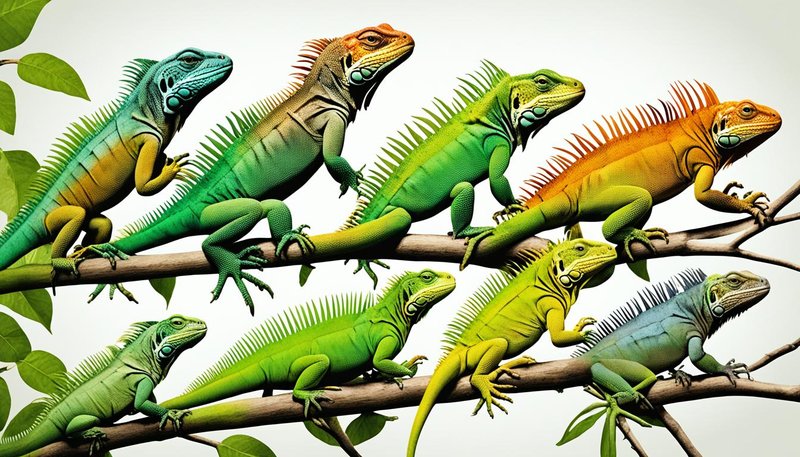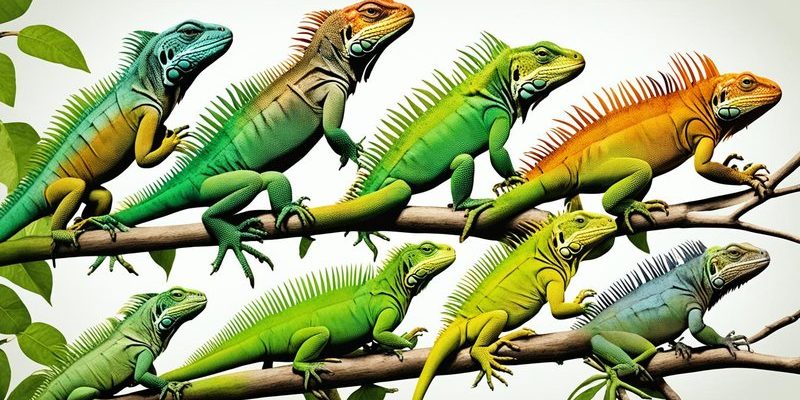
Imagine if you could trace your ancestors back through time, learning how they adapted to their environment, faced challenges, and transformed into who you are today. That’s exactly what scientists do when they study the evolutionary history of iguanas. From their ancient relatives to the vibrant species we see today, the iguana’s history is like a beautiful tapestry woven from the threads of survival, adaptation, and change.
So grab a drink and get comfy, because we’re about to explore the remarkable evolutionary history of the iguana—an adventure that takes us back to ancient times and around the world.
Ancestral Roots: Where Iguanas Began
Iguanas belong to the family Iguanidae, which is part of a larger group of reptiles called Squamata. The story of iguanas starts nearly 250 million years ago, during the Triassic period. At this time, reptiles were just beginning to flourish on Earth. While today’s iguanas might seem a world apart, their ancestors were more akin to the small, lizard-like creatures scuttling through the underbrush.
These early ancestors were not exactly like the iguanas we know today. They were small and quite different in appearance, but they laid the groundwork for all iguanas to come. Over time, as the environment changed and new challenges arose, these reptiles began to evolve and diversify. Isn’t it fascinating to think that the modern iguana is just a continuation of a story that started hundreds of millions of years ago?
From Dinosaurs to Iguanas
As the ages passed, the world experienced one of its most dramatic shifts with the rise of dinosaurs. During this time, the ancestors of iguanas adapted to different habitats, leading to the development of various species. While many reptiles were competing for dominance, iguanas found their niche in warm environments where they could thrive on a diet of plants and fruits.
This adaptability helped iguanas survive through multiple extinction events, including the infamous one that wiped out the dinosaurs around 66 million years ago. Many reptiles perished, but iguanas were resilient, continuing to evolve into distinct species that we recognize today.
Diverse Species: The Iguana Family Tree
There are several species of iguanas, each with its unique traits and habitats. The most well-known include the green iguana, the marine iguana, and the Galápagos land iguana. Each of these species has adapted to its environment in fascinating ways.
For example, the green iguana is primarily arboreal, spending much of its life in trees. Its diet mainly consists of leaves, flowers, and fruit, making it a herbivore. On the other hand, the marine iguana, found only in the Galápagos Islands, has developed the ability to swim and dive in the ocean to forage for algae. This adaptation is a prime example of how iguanas have evolved based on their specific environmental pressures and available resources.
Physical and Behavioral Traits
The evolutionary history of iguanas is also reflected in their physical features. For instance, the marine iguana possesses a flattened body and a long tail, perfect for swimming. Their ability to dive underwater allows them to forage for food, making them unique among lizards.
Behaviorally, iguanas exhibit various adaptations, such as social structures, mating rituals, and territorial displays. Each species has developed its own strategies to survive and reproduce, demonstrating the incredible flexibility of iguanas throughout their history.
Geographical Spread: Where Iguanas Live
Iguanas are primarily found in tropical and subtropical regions of Central and South America, as well as the Caribbean. Their geographical spread is a key part of their evolutionary story. Over millions of years, iguanas migrated to different islands and mainland areas, allowing them to adapt to various climates and ecosystems.
For instance, the Galápagos Islands are home to unique species and subspecies of iguanas that have evolved separately from their mainland relatives. This isolation has led to some remarkable adaptations. The Galápagos land iguana, for example, can endure the harsh conditions of its rocky environment, showcasing how evolutionary pressure can shape a species over time.
Climate Change and Adaptation
Over the years, iguanas have faced numerous challenges, including climate change and habitat loss. These pressures influence their evolution and survival. For example, as temperatures rise and weather patterns shift, some iguana populations might need to adapt by altering their behaviors or expanding their habitats.
This adaptability is crucial for their survival. Scientists study these changes closely to understand how iguanas cope with environmental stresses. It’s a reminder of how interconnected all life is, and that evolution is an ongoing process.
Conservation Efforts: Protecting Iguanas Today
As we’ve learned, the evolutionary history of the iguana is not just about their past; it’s also about their future. Many iguana species are now threatened or endangered due to habitat destruction, hunting, and the pet trade. Conservation efforts are crucial for maintaining biodiversity and ensuring that future generations can experience these remarkable creatures.
Organizations worldwide are working to protect iguana habitats, enforce laws against illegal hunting, and educate local communities about the importance of iguanas in their ecosystems. For example, conservationists often engage in breeding programs that help increase the population of endangered species, such as the Brachylophus vitiensis, or the Fiji iguana.
Community Involvement
Community involvement is essential for successful conservation efforts. If local populations understand the value of iguanas and their ecosystems, they are more likely to take part in protecting them. Educational initiatives can foster a sense of ownership and pride in local wildlife, making a big difference in conservation outcomes.
The evolutionary history of the iguana is a testament to resilience and adaptation. These fascinating reptiles have survived millions of years of change, each species reflecting the unique challenges of its environment. By understanding their past, we can better appreciate their role in our ecosystems and the importance of protecting these remarkable creatures.
As iguanas continue to adapt to modern pressures, it’s clear that their story is far from over. With ongoing conservation efforts and community involvement, we can ensure that these incredible lizards thrive for generations to come. So, the next time you see an iguana basking in the sun, remember that there’s a whole world of history behind its calm exterior—one that deserves our attention and care.

